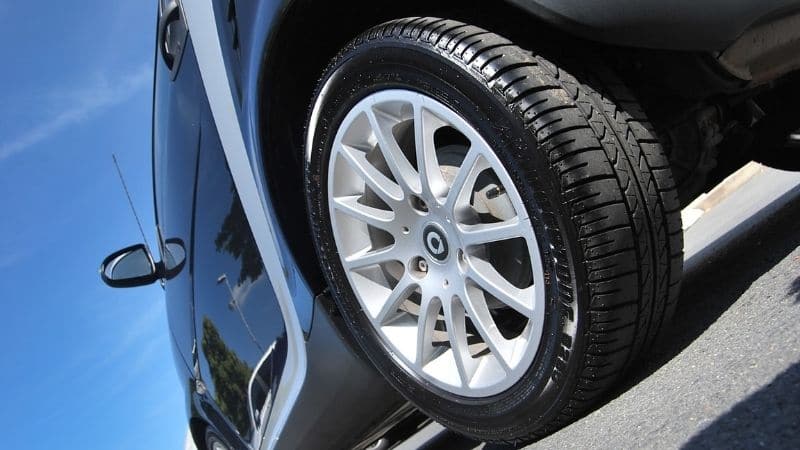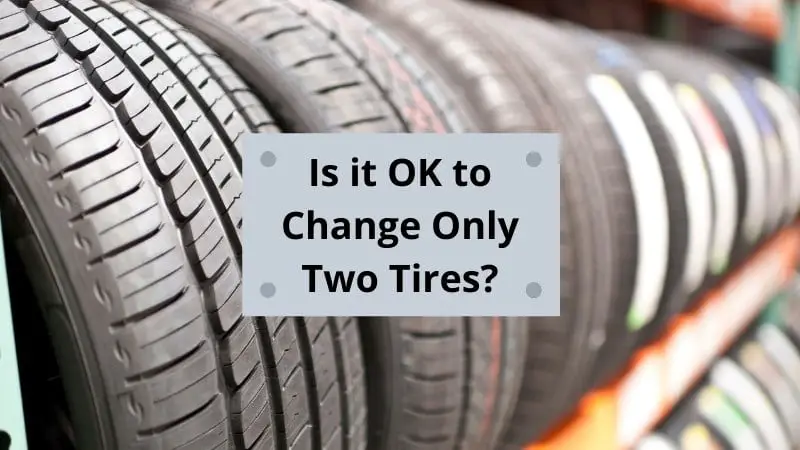It’s time to change tires on your car.
But as you check your tires, you can see that only two of them are worn out to the point that they need to be replaced, while the other two still have some time left.
So, you wonder:
Waht to do? Can I change only the two worn tires, or do I need to change all four at the same time?
It is okay to replace only two tires on your car. Doing so is a better option than replacing only one tire, as that could lead to imbalances between the tires, or buying an entire set of tires when the pre-existing ones can still serve you, as this is unnecessary both environmentally and cost wise.
Read on to learn more about how you should think when it comes to changing only two tires.
Why You May Only Need to Change Two Tires at a Time
The reason why you may only need to replace two tires could be due to unequal inflation and poor wheel alignment that causes tires to wear out faster than the other two.
It could also be due to a destroyed tire that needs replacement while the others are new.
No matter the reason, the big question people have is whether it is okay to fix only two tires on a vehicle and where they should be placed.
When replacing two tires on your car, it’s important to consider whether they should go to the front or rear axle. Most recommendations advise installing the tires on the rear axles.
How Many Tires Should You Change on Your Car?
If it’s been awhile since you changed your tires, you will realize that the tires on the front axle wear out faster than those on the rear axle.
Many people opt for replacing two tires within a given time, which most often is okay to do. And while this may be helpful in some situations.
However, you should install four new tires on your vehicle simultaneously if the following is true for your vehicle:
- Your vehicle have staggered fitment where the wheels on the back are slightly bigger than those on the front, this is common for many, but not all, rear wheel vehicles.
- You have an all-wheel drive vehicle (AWD). AWD vehicles may get issues with the drivetrain when using mismatched tires. A newly installed tire will have a bigger circumference than already used tires with worn-out treads. Therefore, placing new tires on your car’s rear axle will cause an imbalance of how quickly the rear axle spins compared to the front axle that still has the bad tires. When the rear axle spins faster than the front axle, it stresses the drivetrain, which could lead to AWD-sensor problems or even expensive repair costs caused by excessive wear on certain components included along the drivetrain.
What to do Before Replacing The Tires
If the tires on your vehicle are relatively new with minimal wearing, you can only replace two of them (depending on your vehile, as eplained above). The first step is to consult the owner’s manual for recommendations on tire replacements.
If there are no recommendations included, the general rule of thumb is to find the tread difference between the tires on the car and the new ones. They should not be more than 3/32 of an inch.
As explained earlier, it’s easy to replace two tires on a two-wheel-drive car because the systems are less complicated than four-wheel-drive cars. Typically, vehicles have similar size and construction tires on the front and back with equal tread depth.
FWD cars have more weight on the front tires, which wear out faster than those on the rear. This happens because of the acceleration, steering, braking, and engine weight that scrub off more rubber when the vehicle is in contact with the road surface.
Why You Should Place The New Tires on The Rear Axle

Most people think that it is only suitable to place the new tires on the front axle of the vehicle because it’s those that wear out the fastest. While this might make sense, it is crucial to consider that the rear tires might still have some tread life in them that can survive for another year or so.
This means that the two new tires should be installed on the rear axle, while the older tires that were on the rear axle (which will likely have a bit of tread left, becuase they wear out slower than the ones in the front) should be moved to the front axle.
The reason for this trickles down to understeering, oversteering, and the general physics of the car. Hydroplaning is also a big issue with worn-out tires, and if the rear has newer tires, it is easy to handle the car even when the vehicle understeers.
Understeering is primarily attributed to loss of traction on the front axle, but it is much easier to control than oversteer, which is more hazardous. Losing some road grip at the front is much better than the back because it is considered more safe for vehicle handling for most people.
The reasoning behind this is that if the front tires are slightly worn down, the vehicle’s load weight will be transferred to the front to maintain control when stopping.
When driving on wet surfaces, the deeper treads on the tire can quickly disperse excess water. In emergency braking, the vehicle may understeer to give the driver enough time to maneuver and brake.
It is therefore vital that tires are well maintained and rotated. Therefore, drivers should stick to the 5000-7000 miles interval to lower the tread depth difference when replacing tires.
Again however, 4WD and AWD vehicles may cause damage to the differentials, so changing two tires on these cars should be undertaken with great caution.
Why Should You Avoid Replacing Two Tires on an AWD Car?
A car’s front and rear wheels do not wear out all at once, meaning they can go without being replaced entirely.
However, all-wheel drive cars should be balanced at all points to avoid driving issues related to mismatched tires. The following are reasons why you should replace all four tires at the same time if you drive an AWD car:
1. To avoid tire size difference
Newer tires will have a larger diameter even when they are of the same brand as the car awaiting replacement. Even a small amount of wear down on the tires will signify a considerable difference, affecting the vehicle’s handling, explicitly braking and cornering.
The difference matters because the newer tires will be covering more distance than the older ones. This will force the older ones to rotate faster to compensate for the distance covered by the newer tires. Even when the tires are of the same size, the tread depth might have something to do with the revolutions.
2. To avoid AWD sensor triggers
If you are driving an AWD car, you know about the central computers that ensure the cars get the same amount of torque. The same sensors are found in the wheels to monitor speed and traction. Overall, the systems allow the car to be well-grounded on the road surface to reduce slippage when driving.
They also ensure that the driver is in total control of the car wheels. Unfortunately, when these tires have different tread sizes and circumferences, the system will record incorrect readings. These inaccurate readings will alter the entire system controlling other car components and leading to drivetrain problems.
3. To prevent four-wheel lock
When the car systems detect that the tire difference causes the smaller tires to spin faster, the car will be put on a four-wheel lock. This system protects your car from damages to promote better control, especially on wet road surfaces.
Now imagine how dangerous it is when your car locks mid-driving on the highway and at higher speeds. The damage could be costlier than replacing an entire set of wheels.
Conclusion
In conclusion, nothing would frustrate a driver more than replacing all four tires because one or two are not in good condition.
Many will panic into replacing only the affected tires and leaving the rest to achieve their full life. If you ever find yourself in this situation, try to contact a technician for advice on what to do.
Replacing two tires is entirely safe if you have a two-wheel-drive car provided you understand the weight distribution mechanics.
Tire dealers and manufacturers also have their tire rotation policy to help drivers understand where new tires should be installed.
Hi, my name is Niklas, the head content creator & CEO of Whirling Wheelz. I am very interested in vehicles of all kinds, mainly cars. I have a car mechanics degree from high school and a big hobby of mine is to follow the WRC (World Rally Championship) both online and through travel.


